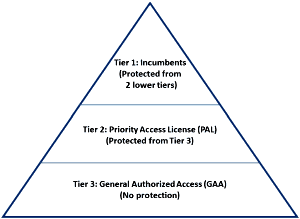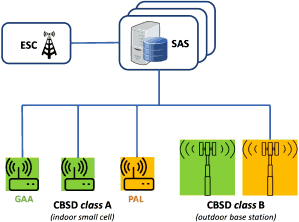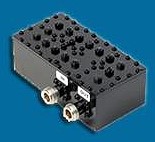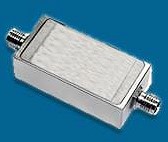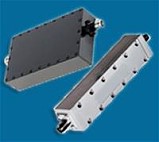Anatech Electronics Newsletter - August 2017 |


Press Release Archives: 2024 | 2023 | 2022 | 2021 |2020 2019 | 2018 | 2017 | 2016 | 2015 2014 | 2013 | 2012 | 2011 | 2010 2009 | 2008 | 2007 | 2006 | 2005 Content is copyright of company represented. Page format, custom text and images are RF Cafe copyright - do not distribute. Anatech Electronics, a manufacturer of RF and microwave filters, has published its August newsletter. In it, Sam Benzacar discusses the Federal Communication Commission's relatively new (2015) three-tiered "spectrum sharing" scheme titled Citizens Broadband Radio Service (CBRS). It provides for 150 MHz of spectrum between 3550 and 3700 MHz. Don't be fooled by the name, though. The "Citizens [broad]Band" nomenclature harkens back to Citizen Band (CB) radio (27 MHz), but CBRS spectrum will be sold to the highest bidder in 10 MHz chunks that are subordinated to primary user claims. So, don't be looking for spread spectrum CB radios in semi rigs or for your family ride anytime soon - Big Bro wants to be able to keep listening to your unsecured conversations. A Word from Sam Benzacar 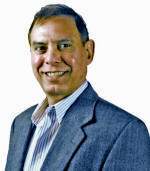 CBRS: Great Opportunities… and Challenges By Sam Benzacar The Citizens Broadband Radio Service (CBRS) is increasingly being recognized as one of the most important opportunities to develop new services ever offered by the Federal Communications Commission. If you've never heard of CBRS it's probably because it's a sleeper when compared to 5G, IoT, and other wireless topics, but that's changing fast. However, this "gift" comes with some caveats. In April 2015, the Federal Communications Commission (FCC) formally established the Citizen Broadband Radio Service (CBRS), which uses "spectrum sharing" in a three-tiered hierarchy to make 150 MHz of spectrum available between 3550 and 3700 MHz.
With CBRS, the highest level of interference protection is provided to incumbent services, which the second tier (PAL) licensees get protection from the bottom-tier GAA users, that receive none. While 150 MHz may not seem like that much spectrum, consider this: A typical wireless carrier "owns" about 130 MHz at various frequencies for all its networks. So 150 MHz of "new" spectrum is quite a bit, almost a third of what the FCC believes is required by 2020 for wireless carriers to accommodate the increasing onslaught of data traffic. The first-priority category in the hierarchy consists of existing services, principally Navy coastal radars and some fixed satellite systems, that have priority over the other two categories. These are, from highest to lowest, Priority Access Licensees (PAL) that will acquire their spectrum through auction and General Authorized Access (GAA) users for whom access is free. The Tier 1 services are protected from interference by the lower two tiers, and the second tier (PAL) is protected from the lowest-tier GAA users. GAA users have no protection. PAL licenses will be auctioned within 100 MHz (3550 to 3650 MHz) of the total for which each licensee receives a 10-MHz channel in a single "census tract" for a renewable term, and no more than seven PALs can operate in each tract. GAA users can use any portion of the full 150 MHz not assigned to higher-tier users. Only digital transmission technologies can be used in all cases and it's likely that LTE will be the choice of most users. A census tract is a portion of a county or other clearly-defined area that the Census Bureau uses to divide up the U.S. With seven PALs per census tract and more than 70,000 tracts, this is supposed to make the cost of PAL licenses far less than what wireless carriers pay for much larger coverage areas. PAL licensees are limited to use of 70 MHz in any census tract, which means the remaining 80 MHz is available to GAA users. The Opportunities Any discussion about LTE networks is also about the major wireless carriers for the obvious reason that they are the only entities that have them, which is because only those with really deep pockets can afford to buy the spectrum and deploy the infrastructure required to use them. This being the case, Wi-Fi is being used by the less well-endowed, a technology never designed for mobility, among other things. CBRS makes LTE networks economically and technically feasible to deploy for the first time. Organizations that need interference protection can choose the second-tier (PAL) and others can take their chances with GAA. As the FCC seems open to proposals for any reasonable application, the possibilities for these networks seem limited only by the imagination. They could provide an alternative for IoT connectivity at the "long-range level" and cable companies could become Mobile Virtual Network Operators (think TracFone of Project Fi), for example. There are dozens of possible scenarios for creating private networks and other uses that will surely be explored in the coming years. Other applications for the spectrum include use by the traditional wireless carriers to add coverage and capacity or backhaul on a licensed or unlicensed basis, and the Distributed Antenna Systems (DAS) operated by neutral hosts. So What's the Catch? CBRS creates "new" spectrum by allowing multiple entities to use it, which produces more capacity without moving incumbent services elsewhere. However, when frequencies are shared they require some form of interference protection such as a "listen-before-talk" approach in which a device senses activity on a specific channel before transmitting. If it detects the presence of another user it moves to another channel. This is used by Wi-Fi, Bluetooth, and other standards with reasonable success in most environments. Another technique called a Spectrum Access System (SAS), used by CBRS and previous attempts at spectrum sharing, is much more ambitious. CBRS mandates that the top-priority incumbent users have as much protection as possible, the PALs less, and GAA users none, which makes for an "interesting" operating environment. The SAS works by managing and enforcing the shared frequencies using a cloud-based database of all CBRS devices to coordinate channel assignments and prevent interference. Among its tasks are assigning channels for CBRS devices, determining their maximum power at every location and ensuring it is not exceeded, registering and authenticating them, and receiving and addressing reports of interference from incumbent users. To protect them, sensors will be deployed near them to detect activity from other services. If it occurs the sensor alerts the SAS, which commands the interfering emitter to change channels.
The SAS uses sensors (the ESC) placed sensors near top-tier sites to detect potential interferers (the CBSDs) and sends information to the SAS that commands devices to change channels if necessary. Characteristics of the CBSDs are defined by the intended use: indoors (small cells, Class A) and outdoors (base stations, Class B). So far, spectrum sharing using an SAS has not been a terrific success. For example, the FCC's plan to free up the TV white spaces created when over-the-air broadcasting transitioned from analog to digital has suffered continuous setbacks, and spectrum management has been one of the major problems. CBRS uses the same basic, database-driven approach and there is no guarantee that it will work this time either, as creating very small coverage areas (the census tracts) to potentially make spectrum more affordable creating a huge challenge for the SAS, which must make decisions in near real time to manage hundreds of thousands of devices (or more) throughout the U.S. If it doesn't perform extremely well, the result will be chaos – and a major interference problem. Nevertheless, smitten by the lure of new revenue streams, companies ranging from component manufacturers to heavy hitters like Alphabet Access (Google), Nokia, Federated Wireless, Verizon, Ericsson, Ruckus Wireless, and cable companies, are already hard at work. Demonstrations and trials are being conducted, certification programs have been created, and device manufacturers are integrating the new frequencies into their chipsets. These are early days, as the first systems are expected to be deployed early next year, there are currently no user devices available with CBRS capability, and it's safe to assume that no one really knows whether the SAS approach will work. If it does, the FCC will have created in CBRS a genuinely useful opportunity for innovation. Check out Our Filter Products
Cavity Band Pass Filters LC Band Pass Filters Cavity Bandstop/Notch Filter About Anatech Electronics Anatech Electronics, Inc. (AEI) specializes in the design and manufacture of standard and custom RF and microwave filters and other passive components and subsystems employed in commercial, industrial, and aerospace and applications. Products are available from an operating frequency range of 10 kHz to 30 GHz and include cavity, ceramic, crystal, LC, and surface acoustic wave (SAW), as well as power combiners/dividers, duplexers and diplexers, directional couplers, terminations, attenuators, circulators, EMI filters, and lightning arrestors. The company's custom products and capabilities are available at www.anatechelectronics.com. Contact: Anatech Electronics, Inc. 70 Outwater Lane Garfield, NJ 07026 (973) 772-4242
Posted September 14, 2017 |
